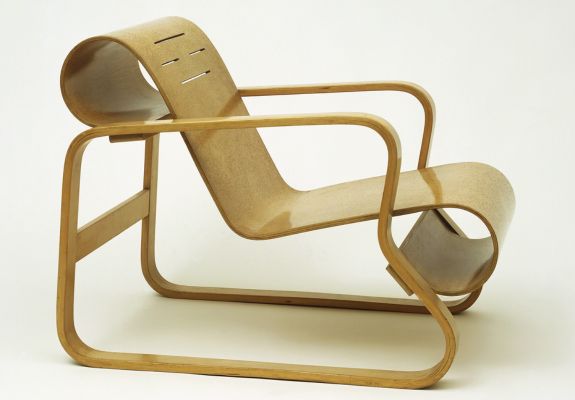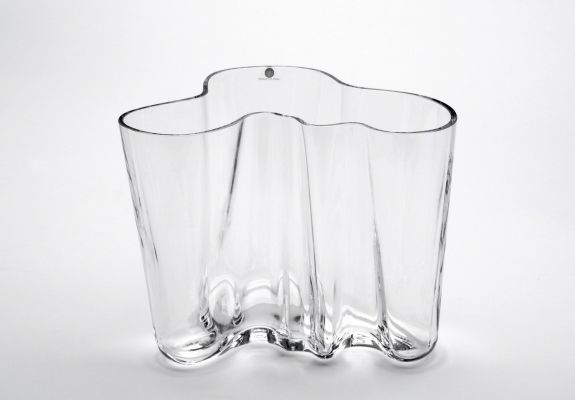Artist Birthday: Alvar Aalto
Alvar Aalto designed all of the furnishings for his buildings. Using native birch, Aalto designed a number of chairs and stools made entirely of bent plywood and laminated wood. He also invented some of the methods for making them. His furniture designs were a synthesis of practical and aesthetic concerns that secured the advantages of machine technology, all characteristics of Bauhaus design. This included the possibility of low-cost, standardized, replicable products.
Artist birthday for February 3rd: Alvar Aalto (1898–1976, Finland)
Alvar Aalto was one of the leading architects and designers of Finnish Modernism.
 |
| Alvar Aalto, Paimio Armchair, 1931–1932. Birch plywood, 26" x 23 ¾" x 34 ½" (66 x 60.3 x 87.6 cm). Image courtesy of the Museum of Modern Art. © 2025 Artists Rights Society (ARS), New York. (MOMA-D0073aaars) |
This armchair—the Paimio chair, also called a ”scroll chair”—is one of Aalto's most famous designs. The seat is made of a single piece of undulating, bent plywood that seemingly floats in the birchwood frame. Inspired by the architect and designer Marcel Breuer’s (1902–1981) Club Chair of 1927–1928, which was made of tubular steel, Aalto chose native birch for its natural feel and insulating properties, and developed a more organic form. His designs of chairs like this are a supreme example in bentwood (wood bent by steam) that tested the limits of plywood manufacturing in the early 1930s. The chair gets its name from a tuberculosis sanitarium in Paimio, Finland, for which the chair was designed.
From 1150 to 1809, Finland was part of Sweden. In 1809, it became a subject duchy of the Russian Empire. The country gained independence after the Russian Revolution of 1917. In a process of restructuring their culture to emphasize indigenous social, artistic and governmental entities, architecture and design were among the first art forms that underwent major changes. A young generation of Finnish artists ushered in a unique “Finnish Style” that looked to the natural beauty of Finland’s spectacular nature for inspiration.
In 1930, the Stockholm Exhibition introduced modernism to Scandinavia (Sweden, Norway, Finland and Denmark) based on the aesthetics developed by the numerous Werkbund studios established in Germanic countries (Germany, Switzerland and Austria), the German Bauhaus, and the Arts and Crafts Movement. Already by that time architecture had undergone a modernization under architects like Alvar Aalto (1898–1976). Following the exhibition, by the end of the 1930s the miscellaneous arts began to exhibit the modernist impulse. After World War II (1939–1945) global exhibitions spread the influence and fame of Finnish modernism, particularly in the forms of furniture, ceramics and glass. By the 1950s, Finnish design had firmly established itself as part of “Scandinavian Design”, along with Sweden and Denmark.
In Finland, the modern style of furniture began after 1917 when Finnish artists were searching for a Finnish national style. The earliest modern furniture designs actually emanated from architects after World War I (1914–1918), when there was a social revolution in housing precipitated a great increase of people moving to urban centers. Furniture needed clean lines and a space saving design to accommodate smaller urban homes, and this resulted in the simplicity and practicality which characterizes the country’s furniture to this very day. Finnish furniture since the 1930s has run the gamut from handmade furniture in the abundant birch tree woods and plywood, to completely industrialized furniture in metal, laminates (composite artificial materials) and plastics. Since lamination was pioneered and perfected (mostly by Aalto) in Finland, Finnish furniture has been primarily a product of the machine.
Finland's great exponent of modernism, Aalto was born in Kuortane, Finland. He enjoyed a rich and varied career as an architect and designer. After graduating as an architect in 1921 from Helsinki Institute of Technology (now part of Aalto University), he set up his first architectural practice in Jyväskyä. His early works were designed in the Nordic Classicism style that was predominant at the time. In the late 1920s and early 1930s, several trips to Europe acquainted him with the International Style, a modernist aesthetic that was greatly predicated upon the modernist experiment of the Bauhaus.
Aalto's early modernist phase was called Functionalism, based on the International Style's emphasis on the idea that form follows function. From the late 1930s on, he enriched his modernism with organic forms, use of natural materials, and increasingly daring open concept in his interiors. In 1935 he formed Artek to promote his growing production and sales of his furniture designs.
 |
| Alvar Aalto, Vase, 1936. Mold-blown glass, 6 ¼" x 8 1⁄16" x 7" (15.9 x 20.6 x 17.8 cm). Image courtesy of the Philadelphia Museum of Art. © 2025 Artists Rights Society (ARS), New York. (PMA-9334aaars) |
Beginning in the early 1930s, Aalto turned his focus away from architecture and devoted considerable effort as a glass designer. He was motivated by the desire to offer people everyday objects that were both derived from nature and accommodated a human sensibility. Aalto created this vase as part of a collection of ten objects that he entered in the 1936 competition to determine what was displayed in the Swedish Pavilion for the 1937 Exposition Universelle in Paris. Aalto won the competition, and his free-form objects, ranging from a shallow dish to a tall vase, enjoyed instant popularity.
This vase, known variously as The Paris Object, the Aalto, and the Savoy, is still in production today as a classic example of the Scandinavian avant-garde. The form of the Savoy vase demonstrates Aalto’s quest in his work of the 1930s for the natural and organic, and also reflects his intense study of the forms of his Finnish homeland’s forests and lakes. Like nature’s random arrangement, the vase’s wave-like, often uneven edges force flowers placed inside to adapt, by either falling against an inward contour or by resting within its undulating form. The oblong expansions of the vase’s shape relate to the profile of Finland’s lakes and bodies of water, while the rippling effect on the sides recalls the lines of trees in the expansive Finnish forests.

Comments